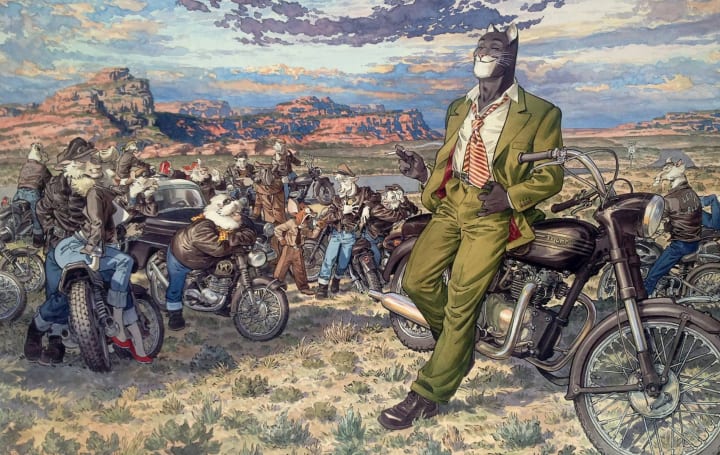
Blacksad is the award winning series of Spanish/French graphic novels by artist Juanjo Guarnido and writer Juan Díaz Canales of a 1950's America where anthropomorphic animals take the place of humanity, starring the perpetually unemployed Private-eye and black cat named Blacksad and his weasel sidekick Weekly. Despite this major difference, the world has mostly followed a similar path to ours. WW2, the Manhattan Project, the Red Scare, the Civil Rights movement, the rise of the Klu Klux Klan, and the Beat Poet movement all occur as they did in our world, only with animals standing in for historical figures or certain social-political groups.
Blacksad himself in not that unique of a character. A hard-boiled detective with a strong sense of right and wrong, but with a massive chip on his shoulders that is the result of his time in the army, always ready to stick up for the little guy. He's the basic archetype of the private-eye working outside the system to bring justice where he sees it sorely needed, with a long list of broken hearts left in his wake wherever he goes. He doesn't stand out much among characters like Sam Spade, Nero Wolfe or Phillip Marlowe, outside of being a cat, of course. At one point he even visually resembles another famous detective with pointed ears and pulp fiction roots: Batman.
Most of the supporting characters are similar archetypes, with the short sidekick Weekly, the stern but fair police commissioner, the corrupt alcoholic rival detective, the kidnapped little girl, the femme fatale, the cold-blooded assassin, etc. However, what makes the Blacksad series unique is not its characters, but two very important factors.

First off, the artwork. Guanido's style fits perfectly with whatever mood is needed for a scene. He can jump from light-hearted physical comedy to thrilling action to heartbreaking somberness with flawless effort. His technique with watercolors is brilliant, using a new palette for each installment, setting the mood by color-coordinating a primary color that sets the tone of the book. The first album is black, the second is white, the third red, the fourth is blue and the fifth is yellow. This subtle method of storytelling truly showcases a brilliant writer/artist collaboration that can be a rare find in comics.
The second factor that makes Blacksad interesting is the setting of the story. A setting that harkens back to old European folk tales and fables in the backdrop of 50's Americana.
While the series first album, “Somewhere Within the Shadows”, was deeply rooted in Raymond Chandler-style detective noir, with its plot revolving around the murder of actress (and feline seductress) Natalia Willford, who was once Blacksad's client and lover. This case leads him down a road littered with conspiracies, assassins, and a corrupt system that leaves the police powerless to act. The series gradually shifted away from its detective roots, allowing for aiming its critical eye at other facets of American culture of the time.
The second album, “Arctic Nation”, took a clever twist on segregation and race relations by taking the term black vs white to its most literal extreme, with white-furred animals clashing against other animals with black fur. This was followed by “Red Soul”, which tackled the red scare, McCathyism (the senator represented here as a rooster) and the escalating fear of nuclear armageddon during the height of the cold war. The fourth, “A Silent Hell”, revolved around jazz, New Orleans and the fallout of corruption and free-market capitalism, and the fifth took a stab at the beat cultural movement, highlighting its more self-destructive aspects, set to a backdrop of a road trip past route 66. All wonderfully drawn books, featuring heavy topics shown in its most brutal honesty, starring animals that wouldn't seem out of place in Disney's Zootopia or a Don Bluth feature (side note: Guarnido was a former animator for Disney, working on such films as “Hercules”, “Tarzan”, and “Brother Bear”).

Blacksad has enraptured many avid comic readers, being a smash hit in its native Spain and each album being a bestseller for publisher Dargaud, and receiving an English translation from Dark Horse Comics in the US. But why is this? Is it the stories? The magnificently well drawn and well-colored art? Or is there something else?
The best way to look at this series is as a view of America from an outsider's perspective. Both creators are of Spanish origin, having been born in the late sixties/early seventies, growing up in a time where 50's nostalgia was on the rise with films like “Grease” and tv shows like “Happy Days”. That is, in the US at least. The people of Spain, however, did not share this love for the decade, mostly due to being ruled by the fascist regime of Fransico Franco from 1939 to 1978. It was a time of censorship and oppression of “non-Spanish” values, which included witch hunts on communists (a theme explored in “Red Soul”) and a muzzle on criticism of the regime. These were years not looked back on fondly by the Spanish, so this worship and longing for “simpler” times that America enveloped itself in must have seemed strange, almost alien to the two creators, whose parents and grandparents experiences the worst that Spain had to suffer through throughout the 20th Century.
This lack of rose-colored glasses allowed the creators to look more critically at a decade that, for many people in both the US and other parts of the world, was very unforgiving. Free from this, the duo of Guarnido and Canales threw themselves headlong into a story that both captures the optimism of the decade, without shying away from the harsh realities that lied beneath.
The series does not outright condemn the post-war era or course. Far from it, the creators go out of their way to make loving references to the Science Fiction Monster movie boom, modern art, the works of Billie Holiday, Walt Disney, Charlie Parker and Harvey Kurtzman. Important figures even appear through the use of stand-ins, such as Marilyn Monroe (as a cat), Marlon Brando (as a sheep), Mark Rothko (as a bear), Allen Ginsberg (as a buffalo) and William S. Burroughs (as a flamingo}. The creators are obviously aware of the cultural impact and importance of the decade. But they are not hesitant to shine a light on its darker aspects.
As mentioned earlier, the second album takes a hard swipe against segregation and systematized racism that was rampant at the time. Its first page even included the lynching of a black vulture by the KKK stand-in, Arctic Nation. The social status of women is also briefly analyzed, with one female character lamenting how she “plays” the role she is expected to play: that of a perfect WASP housewife. And then we haven't even gotten to the third and fourth albums, with blows taken against the House Un-American Activities Committee and capitalism at the expense of the lower classes.

Does Blacksad have political agenda dressed up in comic book form? Not really. At least, not in an overt way. The character Blacksad is never seen leaning toward any particular view of the political spectrum, other than his need to stick up for the oppressed and his own sense of justice. It instead speaks more to common decency and presents real-world issues in the same way a fable does: using animals as symbolic stand-ins. The ridiculousness of bigotry based on skin color is lampooned at every turn, to the point where Blacksad is referred to by a red parrot as “colored”. The idea of being enemies based on heritage is lampshaded with Blacksad's friendship with the police commissioner Smirnov, a German Shepherd. Similar to Art Spiegelman's “Maus”, the series doesn't shy away from using animal stereotypes and attributes for humor (a doomsday cult comprised of lemmings), character building (a corrupt toad who prides himself for his “cold-blood”) and poignant commentary (the aforementioned race relations).
The series main trait is simple: it is inherently romantic. It looks to the future with unfaltering optimism. It doesn't shy away from the bad, the dark, and the truly reprehensible things humanity is capable of by showing them being committed by (often cute and charming) animals. But it nevertheless leaves the reader with some sense of hope, even when the series reaches its most darker moments. The characters struggle, often fail and are often left as pyrrhic victors, yet they muster on. It wishes to impart simple lessons about acceptance, abuse of power, self-sacrifice and the lack of satisfying conclusions in real life onto the reader, using stories where animals are the leads. A modern fable drenched in the watercolors of 1950's Americana.
Blacksad is published by Dargaud. Available in English from Dark Horse Comics.
- Blacksad HC (contains volume 1 through 3)
- Blacksad: A Silent Hell
- Blacksad: Amarillo
About the Creator
Joachim Heijndermans
Joachim is a freelance artist and writer. He writes short stories and draws comics. Likes to travel, paint, collect rare toys, and read in his spare time. His fiction writing has been featured in magazines, websites, podcasts and television






Comments
There are no comments for this story
Be the first to respond and start the conversation.